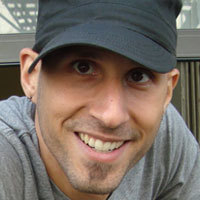I started urban gardening in the spring of 2009 with my fire escape garden in New York City. When I started, I didn’t have any previous experience, and never took any classes or read any books.
There were a few reasons that I wanted to grow my own food. First, I eat a lot of organic produce, and thought that I could cut into my grocery bill. The other reason is that I started to become more conscious and aware of where my food was coming from.
At the time, I was living in New York City. In looking at the labels on my produce, I realized that the food was coming from faraway places such as Mexico, Chile and Israel. I was reading the book Plenty, which said that on average food travels from farm to plate nearly 1,500 miles.
That number astonished me for several reasons, the first being the environmental factor. Produce is being shipped across the world, which utilizes lots of unnecessary oil. But, who is handling my food? How are they really growing it? How are the workers being treated? What happens to the food after it’s picked and travels all that distance to make its way to my plate?
These factors got me thinking about how I could grow some of my own food.
I started to do some research, and got a few books from the library, none of which really kept my interest. I decided to just do it. After all, what did people do hundreds of years ago? They certainly didn’t Google “gardening” or consult an expert with a fancy piece of paper.
Besides growing my own food, part of this project aims to reuse materials that are readily available and save some items from being tossed into the landfill.
With the little research that I did, I used nearly all recycled materials to make self-watering containers for less than $5. I used soda bottles to make hanging planters for my fire escape as well.
On my little 2×3 plot of “land” I had three self-watering containers and 10 hanging planters. I was able to grow cherry tomatoes, lettuces, kale, mint, oregano, peppers, tarragon and more.
Since I was generating so many food scraps, I also built a small indoor compost bin in my kitchen to feed my garden.
My goal for this project was to get one salad, which I did after the first month. Now, instead of tracing my food thousands of miles away, I’m able to trace my produce a few steps outside of my apartment.
I have since moved to Los Angeles, where I’m about to start a balcony garden.
Getting started was the biggest hurdle for me, and it is for most people. One of my goals is to get you to start your own vegetable garden and grow your own food. It doesn’t have to be to a huge garden. Just one plant. If I can do it, why can’t you?
 Mike Lieberman prides himself as a living, breathing demonstration of how one can live sustainably, anywhere. On his sites he documents what he is doing through urban gardening, creating raw vegan recipes and demonstrating simple ways to go green. Lieberman thinks that most people believe that living sustainably and making eco-friendly decisions is difficult and cannot be done — that it’s an all-or-nothing-type game. Through his writing, he wants to show you that it’s simple to make these decisions. Some or all of these steps can easily be done in your daily lives without any disruption, and he would like to show you how to do them. Follow him on Twitter @CanarsieBK and check out his online portfolio on CanarsieBK.com.
Mike Lieberman prides himself as a living, breathing demonstration of how one can live sustainably, anywhere. On his sites he documents what he is doing through urban gardening, creating raw vegan recipes and demonstrating simple ways to go green. Lieberman thinks that most people believe that living sustainably and making eco-friendly decisions is difficult and cannot be done — that it’s an all-or-nothing-type game. Through his writing, he wants to show you that it’s simple to make these decisions. Some or all of these steps can easily be done in your daily lives without any disruption, and he would like to show you how to do them. Follow him on Twitter @CanarsieBK and check out his online portfolio on CanarsieBK.com.
 Mike Lieberman prides himself as a living, breathing demonstration of how one can live sustainably, anywhere. On his sites he documents what he is doing through urban gardening, creating raw vegan recipes and demonstrating simple ways to go green. Lieberman thinks that most people believe that living sustainably and making eco-friendly decisions is difficult and cannot be done — that it’s an all-or-nothing-type game. Through his writing, he wants to show you that it’s simple to make these decisions. Some or all of these steps can easily be done in your daily lives without any disruption, and he would like to show you how to do them. Follow him on Twitter @CanarsieBK and check out his online portfolio on CanarsieBK.com.
Mike Lieberman prides himself as a living, breathing demonstration of how one can live sustainably, anywhere. On his sites he documents what he is doing through urban gardening, creating raw vegan recipes and demonstrating simple ways to go green. Lieberman thinks that most people believe that living sustainably and making eco-friendly decisions is difficult and cannot be done — that it’s an all-or-nothing-type game. Through his writing, he wants to show you that it’s simple to make these decisions. Some or all of these steps can easily be done in your daily lives without any disruption, and he would like to show you how to do them. Follow him on Twitter @CanarsieBK and check out his online portfolio on CanarsieBK.com.